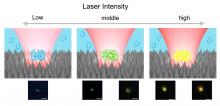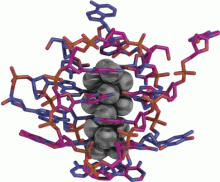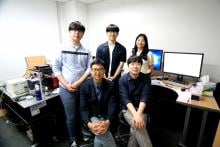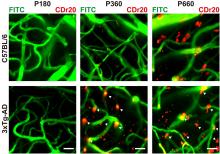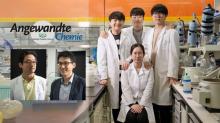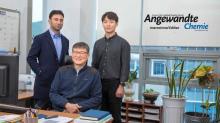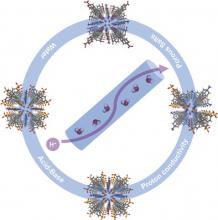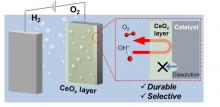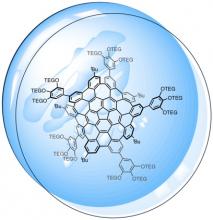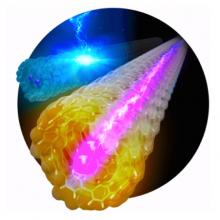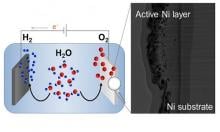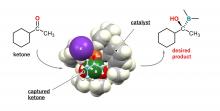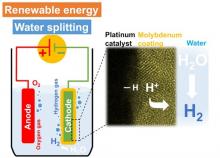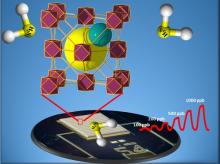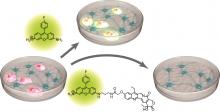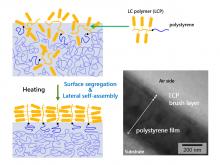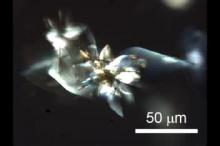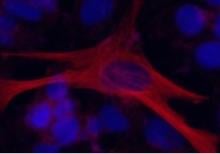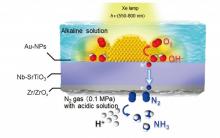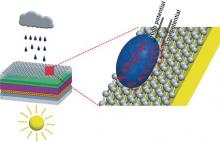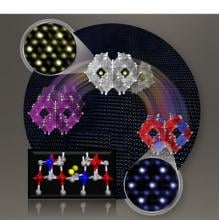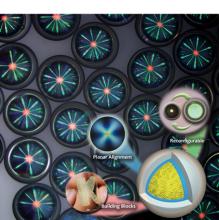Angewandte Chemie
News
28 Feb 2022
Scientists demonstrate an optical trapping technique using nanotextured black silicon that can efficiently trap polymer chains. By adjusting the laser intensity, these “optical tweezers” can control the florescence color emitted through a local concentration of a perylene-modified polymer solution. From a low intensity blue to high intensity orange, this reversible and fully remote technology can almost reach the entire RGB spectrum.

02 Feb 2021
Carbon dioxide (CO2) is one of the major greenhouse gases causing global warming. If the carbon dioxide could be converted into energy, it would be killing two birds with one stone in addressing the environmental issues. A joint research team led by City University of Hong Kong (CityU) has developed a new photocatalyst which can produce methane fuel (CH4) selectively and effectively from carbon dioxide using sunlight. According to their research, the quantity of methane produced was almost doubled in the first 8 hours of the reaction process.
20 Nov 2020
A research team, affiliated with South Korea's Ulsan National Institute of Science and Technology (UNIST) has unveiled a new eco-friendly and low-cost method to synthesize indolopyran, one type of nitrogen ring compound, contained in about 60% of drugs that are recently approved by FDA.
20 Nov 2020
A research team, affiliated with South Korea's Ulsan National Institute of Science and Technology (UNIST) has proposed a new experimental approach for estimating the H‐bond free energy of local biological water.
11 Sep 2019
Determination of the crystal structure of a DNA-stabilized silver nanocluster
04 Jul 2019
Joint research team of Professors Jaeheung Cho and Daeha Seo in the Department of Emerging Materials Science developed a technology to control the generation of nitric oxide in cells. Proposed the possibility of additional research related to cell signal transfer.
02 May 2019
Researchers in South Korea and Singapore have, for the first time, developed a chemical probe that enables live-imaging of a type of immune cells in the brain, known as microglia, in a live animal brain.
22 Jan 2019
A new type of organic solar cells with high flexibility can withstand up to 100 continual bending/unbending cycles.
12 Nov 2018
Scientists have discovered a novel method to synthesize furan-2,5-dicarboxylic acid (FDCA) in a high yield from a glucose derivative of non-food plant cellulose, paving the way for replacing petroleum-derived terephthalic acid with biomaterials in plastic bottle applications.
16 Aug 2018
Promising photostable tool for single molecule tracking and multicolor imaging.
11 Jun 2018
Nagoya University researchers use E.coli to convert benzene into phenol, simplifying a chemical reaction that is difficult by conventional methods
24 May 2018
A team of researchers, affiliated with South Korea's Ulsan National Institute of Science and Technology (UNIST) has introduced novel solution for hydrogen storage
18 Apr 2018
A porous cerium-based coating boosts the durability of oxygen-forming catalysts while maintaining their inherent water-splitting activity.
19 Feb 2018
~ A new water-soluble nanocarbon triggers cell death when exposed to light ~

03 Oct 2017
The molten surface of a sodium-based material could assist the direct conversion of methane to useful building blocks.
24 Jul 2017
Scientists at Nagoya University have developed a new way to make stimuli-responsive materials in a predictable manner. They used this method to design a new material, a mixture of carbon nanorings and iodine, which conducts electricity and emits white light when exposed to electricity.
02 Jul 2017
A technique to create a material for cost-effective water electrolysis uses a simple chemical method for preparing nickel-based anodes to improve the oxygen-evolution reaction. Efficiency gains like this one developed by KAUST are important in evolving renewable energy.
09 Jun 2017
A team of Hokkaido University researchers has developed the world’s first method to achieve the catalytic asymmetric borylation of ketones, a breakthrough expected to facilitate the development of new medicines and functional chemicals.
06 Jun 2017
A coating of molybdenum improves the efficiency of catalysts for producing hydrogen.
06 Mar 2017
Tunable porous MOF materials interface with electrodes to sound the alarm at the first sniff of hydrogen sulfide.
19 Jan 2017
A new compound could help rid stem cell samples of potentially tumorigenic cells, making them safer for regenerative therapies.
20 Oct 2016
Japanese researchers have developed a new approach for obtaining functional surfaces consisting of organized polymers.
04 Aug 2016
Ulsan National Institute of Science and Technology (UNIST), South Korea, is well-represented 2016 List of Most Cited Researchers in Materials Science and Engineering (MSE) by Elsevier Scopus Data, which includes only the top 300 of the world's researchers in the field of MSE ranked by the total citations of their papers.
04 Jul 2016
Scientists at Japan’s Hokkaido University have developed light-powered molecular motors that repetitively bend and unbend, bringing us closer to molecular robots.
01 Jul 2016
Scientists at Hokkaido University in Japan have developed a new technique to unleash silenced genes and change cell fates using CRISPR/Cas9.
14 Apr 2016
By using a photoelectrode in which gold nanoparticles are loaded on an oxide semiconductor substrate, a research at Hokkaido University, Japan, has worked to develop a method of artificial photosynthesis that has received attention as an ultimate light energy conversion system.
01 Apr 2016
Graphene layer could allow solar cells to generate power when it rains.
17 Mar 2016
Atomic motion in a crystalline oxide that was used as a cathode in Li-ion batteries was directly demonstrated by state-of-an-art transmission electron microscopy, revealing the transient pathway of a chemical ordering reaction.
16 Mar 2016
Photonic microcapsules confining cholesteric liquid crystals are microfluidically produced, potentially serving as building blocks to compose any shapes of photonic devices.
Events
Sorry, no events coming up for this topic.
Researchers
Sorry, no researchers coming up for this topic.
Giants in history
Sorry, no researchers coming up for this topic.


